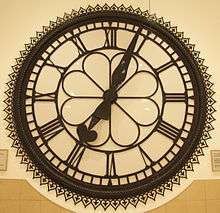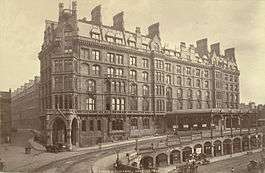St Enoch railway station
| Glasgow St Enoch | |
|---|---|
|
St Enoch railway station hotel in 1879. Photograph by James Valentine | |
| Location | |
| Place | Glasgow |
| Area | Glasgow |
| Coordinates | 55°51′26″N 4°15′13″W / 55.85730°N 4.25370°WCoordinates: 55°51′26″N 4°15′13″W / 55.85730°N 4.25370°W |
| Grid reference | NS589649 |
| Operations | |
| Original company | City of Glasgow Union Railway |
| Pre-grouping | Glasgow and South Western Railway |
| Post-grouping | LMS |
| Platforms | 12 |
| History | |
| 12 December 1870 | Dunlop Street station opened[1] |
| 17 October 1876 | Dunlop Street station closed[1] |
| 17 October 1876 | Opened[1] |
| 27 June 1966 | Closed[1] |
| Disused railway stations in the United Kingdom | |
|
Closed railway stations in Britain A B C D–F G H–J K–L M–O P–R S T–V W–Z | |
|
| |
St Enoch station was a mainline railway station in the city of Glasgow, Scotland between 1876 and 1966. It was demolished in 1977. The hotel was the first building in Glasgow to be fitted out with electric lighting.
History

Located on St Enoch Square in the city centre, it was opened by the City of Glasgow Union Railway in 1876.[1][2] The first passenger train stopped there on 1 May 1876 and the official opening took place on 17 October 1876.[2]
In 1883 it was taken over by the Glasgow and South Western Railway (G&SWR) and it became their headquarters.[2] Services ran to most parts of the G&SWR system, including Ayr, Dumfries, Carlisle, Kilmarnock and Stranraer. In partnership with the Midland Railway, through services also ran to England, using the Settle and Carlisle Railway from Carlisle to Leeds, Sheffield, Derby and London St Pancras.
It was the site of a rail crash in 1903 in which 16 passengers were killed and 64 injured when a train overran the buffers. In the 1923 grouping it was taken over and then operated by the London Midland and Scottish Railway. After the nationalisation of the United Kingdom rail network, the station was run by British Railways.
The suburban service to East Kilbride was diverted to St Enoch in 1959, when all but three services were dieselised. The diversion was said to be necessary to reduce the numbers of trains at Glasgow Central.[3]

It was a large station with 12 platforms and two impressive semi-cylindrical glass/iron roofed train sheds. The station was closed on 27 June 1966[1] as part of the rationalisation of the railway system undertaken by the British Railways Board chairman Dr. Richard Beeching; upon closure its 250 trains and 23,000 passengers a day were diverted to Central.[4] The roofs of the structure were demolished, despite protests, in 1977.[5] The clock that was suspended from the roof of the station was saved from destruction and is now on display in Cumbernauld Town Centre.[6]
The St Enoch Hotel which fronted the station was also demolished in 1977.[5]
Current site
The site of the station is now occupied by another glass structure, the St Enoch Centre, a large shopping centre. The remains of the station and hotel were used to help in fill the Queen's Dock, today the home of the Scottish Exhibition and Conference Centre (SECC).[5]
The red sandstone ticket hall which stands in St Enoch Square immediately west of the shopping centre is not part of the former rail station, but is the former ticket hall for the adjacent St Enoch subway station on the Glasgow Subway.
Though the mainline station is gone, parts of the arcaded approach embankments (now containing shops and restaurants) can be seen to the east of the shopping centre's car park on Osborne Street.[7] Although the short remaining section which once led into the station now goes nowhere, the southern section remains as a freight line along the route of the Glasgow City Union Railway, crossing the Clydebridge Viaduct of 1899 which spans the River Clyde.[8]
Dunlop Street railway station
St Enoch station replaced a previous station close by called Glasgow Dunlop Street, which was opened by the City of Glasgow Union Railway on 12 December 1870[1] and closed by the Glasgow and South Western Railway the same day St Enoch opened.[1]
Services
| Glasgow Central & St Enoch approaches |
|---|
Legend |
| Preceding station | Historical railways | Following station | ||
|---|---|---|---|---|
| Terminus | North British Railway City of Glasgow Union Railway |
Gallowgate | ||
| Terminus | Glasgow and South Western Railway Glasgow, Barrhead and Neilston Direct Railway |
Gorbals | ||
| Terminus | Glasgow and South Western Railway City of Glasgow Union Railway |
Main Street | ||
References
Notes
- 1 2 3 4 5 6 7 8 Butt (1995), page 103
- 1 2 3 Thomas (1971)
- ↑ Railway Magazine October 1959 p. 728
- ↑ "Passengers centralised". Railway Magazine. 112 (784): 429. August 1966.
- 1 2 3 Williams (1999)
- ↑ Seen in the 1981 film Gregory's Girl
- ↑ "Aerial view of Osborne Street, Glasgow showing approach viaduct to the extinct St Enoch Station". Retrieved February 10, 2008.
- ↑ http://urbanglasgow.co.uk/archive/city-of-glasgow-union-railway__o_t__t_3188.html
Sources
- Butt, R. V. J. (1995). The Directory of Railway Stations: details every public and private passenger station, halt, platform and stopping place, past and present (1st ed.). Sparkford: Patrick Stephens Ltd. ISBN 1-8526-0508-1. OCLC 60251199.
- Johnston, Colin; Hulme, John H. (1979). Glasgow Stations (1st ed.). Newton Abbott, Devon: David & Charles. ISBN 0-7153-7569-5. OCLC 6091133.
- Jowett, Alan (March 1989). Jowett's Railway Atlas of Great Britain and Ireland: From Pre-Grouping to the Present Day (1st ed.). Sparkford: Patrick Stephens Ltd. ISBN 1-8526-0086-1. OCLC 22311137.
- Thomas, John (1971). A Regional History of the Railways of Great Britain. VI Scotland: The Lowlands and the Borders (1st ed.). Newton Abbot, Devon: David & Charles. ISBN 0-7153-5408-6. OCLC 16198685.
- Thomas, John; Paterson, Rev A. J. S. (1984). A Regional History of the Railways of Great Britain. VI Scotland: The Lowlands and the Borders (2nd ed.). Newton Abbott, Devon: David & Charles. ISBN 0-9465-3712-7. OCLC 12521072.
- Williams, David (January 1999). The Glasgow guide : guided walks through old and new Glasgow. Edinburgh: Canongate. ISBN 0-86241-840-2. OCLC 40685704.
